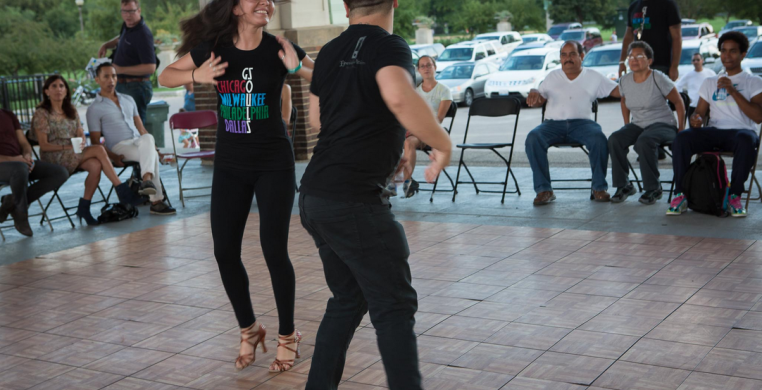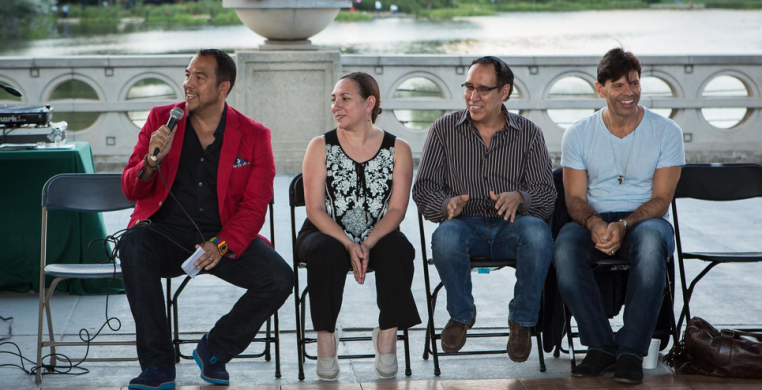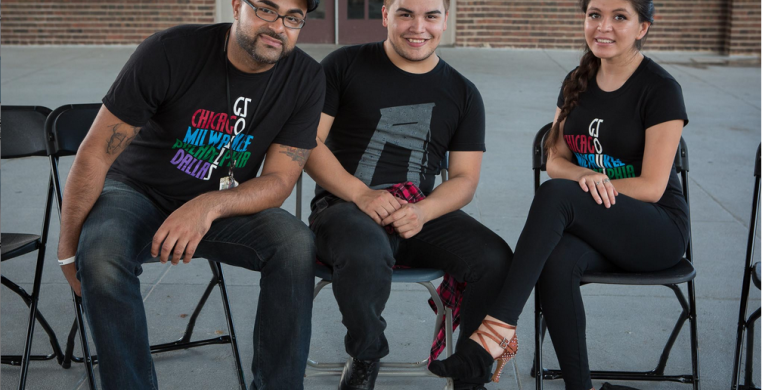It began with a dance.
On August 19 at the Humboldt Park Boat House, a young couple stepped onto a makeshift dance floor, performing a short but engaging piece of choreography by independent artist Rocky Quinones. Quinones’ fusion—a blend of traditional Bachata meshed with the urban flare of streetwise hip hop—sparked the dialogue for Audience Architect’s Moving Dialogs: “Nuestros Bailes e Identidades” (“Our Dances and Identities”), a discussion about culture, race and individuality through the lens of Latino folkloric and contemporary dance.
There was much to discuss. Former Chicago resident Eduardo Vilaro, now artistic director of the New York City-based Ballet Hispanico, served as moderator, taking a page from Liz Lerman’s book and opening the floor to audience members to get their impressions of Quinones’ work.
Sensual. Dynamic. Diverse. Different. Just some of the words people used to describe the piece. The panelists, Irma Suarez Ruiz and Jorge Perez (associate artistic director and executive director of Ensemble Español Spanish Dance Theater, respectively) and Chicago native Ron De Jesus (artistic director of Ron De Jesus Dance) agreed. It was a nice mix of old and new, which proved to be the most poignant themes of Tuesday night’s event.
The impending conversation ran the gamut of emotions—everything from the deep seeded roots of ancestral slavery to the gentrification of Chicago’s Hispanic neighborhoods to the personal stories that inspired each panelist to take up dance in the first place. De Jesus, for his own part, reminisced about growing up in and around Humboldt Park, developing a penchant for urban styles of movement as part of an after-school program that aimed to keep kids off the streets by offering impromptu dance classes. Growing up, Perez recalled how he frequently introduced himself as “George” rather than “Jorge,” a habit he adopted through college until his mentor, Dame Libby Komaiko, founder of Ensemble Español, corrected him: “She said, ‘Your name is ‘Jorge.’” Ruiz spoke of seeing folkloric dance for the first time as an eight-year-old, praying that she would one day wear the colorful costumes of Ensemble Español. “The sounds, the colors, the power resonated with me,” she said.
At one point, Vilaro asked how tradition factored into each artist’s respective work, a question that drew considerable pause. Some expressed the necessity to keep folkloric dance as authentic and traditional as possible, while De Jesus offered up an interesting notion: “Tradition is how things are passed on, but part of our history is also how things evolve,” he said, suggesting the need to advance the form in new ways.
Would that dilute the essence of tradition and identity?
Vilaro once again opened the floor for questions. A gentleman expressed a certain level of frustration with the convictions of his friends. They’d been debating, he recalled, the origin of Salsa dance. The gentleman suggested that Salsa originated in his family’s native Puerto Rico, while his friends—whose families hailed from places all over Latin America—argued in favor of their respective nationalities. In the end, according to the gent, the conversation seemed to generate animosity between them.
“What do you guys think,” he asked, hoping the experts might clarify.
Attempting to find some sort of middle ground, the panelists responded thoughtfully to an ostensibly delicate subject. Quinones answered with fitting optimism, bringing the crowd full circle. “Everyone wants to believe they started the trend. The cool thing is that we’re able to share ideas and keep the art form fresh, start a whole new identity together. Isn’t that why we’re all sitting here now?”





